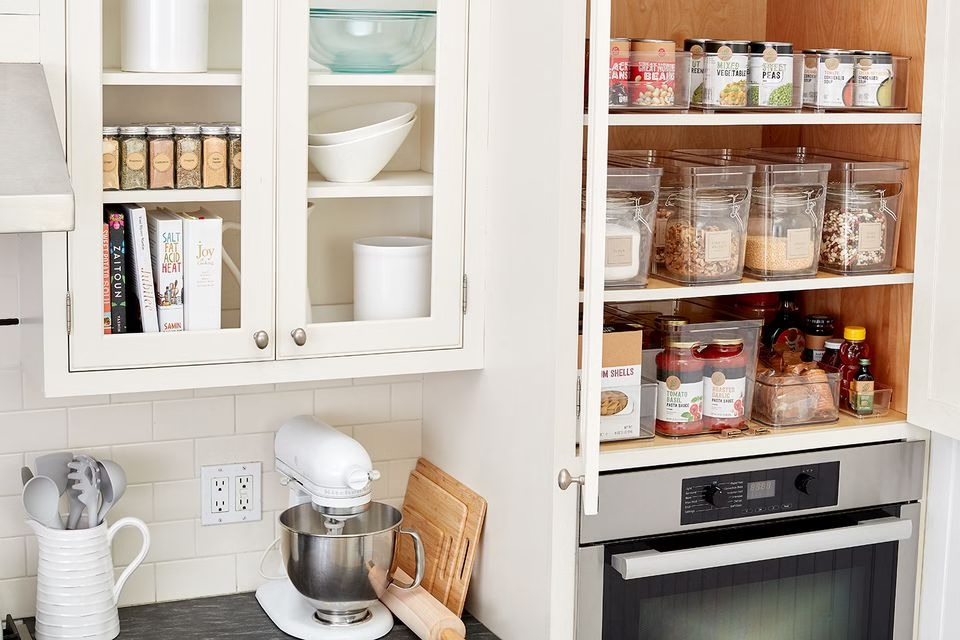In the heart of every Kenyan home lies the kitchen, and within it, often the pantry – a vital hub for all culinary activities. Whether you boast a spacious walk-in pantry, a series of built-in cabinets, or a cleverly repurposed cupboard, an organized pantry is the secret ingredient to effortless meal preparation, reduced food waste, and a generally calmer household. Picture this: no more frantic searches for that pilau spice or wondering if you’re out of unga!
At Retail Place, we understand the unique ingredients and demands of Kenyan cooking. This comprehensive guide offers practical, actionable pantry organization tips tailored for Nairobi homes and beyond, transforming your food storage from a chaotic jumble into a functional, efficient, and even aesthetically pleasing space.
Why an Organized Pantry is Indispensable for Kenyan Households
The benefits of a well-structured pantry extend far beyond just looking good:
- Saves Precious Time: Imagine quickly grabbing exactly what you need for sukuma wiki and ugali without rummaging. An organized pantry streamlines your cooking process.
- Minimizes Food Waste: When everything is visible, you’re more likely to use ingredients before they expire. This is crucial for managing household budgets and reducing spoilage.
- Prevents Duplicate Purchases: A clear inventory means you won’t accidentally buy another packet of dengu when you already have three hidden away.
- Maximizes Limited Space: Many Kenyan homes, especially in urban areas, have compact kitchens. Smart organization utilizes every inch, from vertical height to the back of doors, creating more storage than you thought possible.
- Improves Hygiene & Pest Control: A tidy pantry is easier to clean, making it less inviting for pests like weevils, ants, and cockroaches that thrive in hidden, cluttered spaces.
- Reduces Stress: A visually calm and functional pantry contributes to a more relaxed cooking environment, making your time in the kitchen enjoyable.
Read: Practical Tips to Reduce Food Waste in Nairobi.
The Ultimate Pantry Organization Strategy for Kenyan Homes: Step-by-Step
Transforming your pantry might seem daunting, but a systematic approach makes it manageable and rewarding.
Step 1: The Grand Purge – Empty, Evaluate, Eliminate!
This is the most crucial step. You can’t organize clutter.
- Empty Everything Out: Yes, everything! Pull all items from your pantry, cabinets, and shelves. Place them on a large table, countertop, or even a clean mat on the floor.
- Clean the Space: While empty, wipe down all shelves, drawers, and walls. Vacuum any crumbs or debris. Consider adding shelf liners for easier cleaning in the future.
- Evaluate Each Item (The “Keep, Donate, Trash” Method):
- Trash/Compost: Discard anything expired, stale, spoiled, opened but unusable, or broken. Be ruthless. Check those spices you haven’t used since last Christmas!
- Donate/Give Away: For non-perishable, unopened, and unexpired items you no longer need or want (e.g., extra packs of lentils, a flavour you tried once and disliked), consider donating to local food drives, charities, or offering to friends and family.
- Relocate: Items that don’t belong in the pantry (e.g., cleaning supplies that belong in the laundry, non-food items, children’s toys). Put them in a temporary “Relocate” box.
- Keep: Only items that are fresh, unexpired, and you genuinely use and love.
Read: Essential Kitchen Decluttering Tips for Kenyan Homes.
Step 2: Categorize Like a Pro – Grouping for Efficiency
Now that you have only the “keepers,” group them logically. Think about how you cook.
- Dry Staples: Unga (maize flour), rice, beans (maharagwe, njugu), pasta, sugar, salt, lentils, oats.
- Baking Supplies: Flours (wheat, self-raising), baking powder, soda bicarbonate, vanilla essence, cocoa powder, sprinkles.
- Spices & Seasonings: All your dawa, pilau masala, curry powder, salts, peppers, and dried herbs.
- Oils & Vinegars: Cooking oils (mafuta), olive oil, various vinegars.
- Canned Goods: Tins of beans, tomatoes, fish, vegetables.
- Snacks: Biscuits, crisps, nuts, dried fruits.
- Breakfast Items: Cereals, tea, coffee, hot chocolate, porridge oats.
- Sauces & Condiments: Soy sauce, hot sauces, tomato paste, ketchup (if not refrigerated).
- Breakfast Area for Kids (lower shelves): If you have kids, create an accessible zone for their snacks and breakfast items to promote independence.
Read: The Essential Pantry Categories for a Kenyan Kitchen.
Step 3: Choose Smart Storage Solutions – Maximize Every Inch
This is where organization tools shine. Look for items widely available in Kenyan stores.
Airtight Containers (Plastic or Glass):
- Why: Essential for dry staples. They keep food fresh, prevent pests (critical in Kenya’s climate!), make contents visible, and create a uniform, tidy look.
- What to Look For: BPA-free plastic (like Lock & Lock, Kenpoly Homefresh series, or other good quality options from supermarkets) or durable glass (like Glasslock). Look for stackable, clear designs.
- Use for: Unga, rice, sugar, tea bags, coffee, cereals, pulses, pasta, nuts, dried fruits.
Shelf Risers/Expandable Shelves:
- Why: Immediately doubles your vertical storage space in taller cabinets, allowing you to stack items like tins, small plates, or mugs without creating wobbly towers.
- What to Look For: Sturdy metal or plastic designs, widely available in supermarkets and general home goods stores.
Tiered Can Organizers:
- Why: Keep canned goods neat and visible, allowing you to easily see what you have and rotate stock (first-in, first-out).
- What to Look For: Plastic or metal, often expandable.
Lazy Susans (Turntables):
- Why: Perfect for corner cabinets or deep shelves. Spin to easily access oils, sauces, spices, or condiments without digging.
- What to Look For: Plastic or bamboo, with a non-skid surface.
- Where to Buy: Explore a wide variety of Lazy Susans at Jumia Kenya.
Clear Bins/Baskets:
- Why: Contain “like” items, especially odd-shaped packets or snacks. Pull out the whole bin to access contents.
- What to Look For: Clear plastic bins are best for visibility. Wire or natural fibre baskets (kiondo or sisal) add a lovely aesthetic for items like potatoes/onions (that need air) or bulk snacks.
Drawer Dividers:
- Why: For pantry drawers, these are great for organizing smaller items like spice packets, tea bags, or baking ingredients.
Over-the-Door Organizers:
- Why: Utilizes often-wasted space on the inside of a pantry door. Great for light items like spice sachets, cling film, foil, or small cleaning supplies.
- What to Look For: Wire racks or multi-pocket fabric organizers that hang securely.
Step 4: Label Everything! – The Power of Identification
Don’t skip this! Even if containers are clear, labels confirm contents at a glance.
- Clear Labels: Use permanent markers on reusable labels, or apply sticker labels.
- Include Expiry Dates: For dry goods you’ve decanted, write the expiry date from the original packaging onto the label.
- Consistency: Choose a labeling system that works for you – handwritten, printed, or even chalk labels.
Step 5: Zone Your Pantry – Create an Intuitive Layout
Arrange items based on frequency of use and logical categories.
- Eye Level (Most Used): Everyday staples like unga, rice, sugar, tea, coffee, frequently used spices.
- Below Eye Level (Heavy/Bulk/Kids’ Zone): Heavy items like large oil bottles, bags of potatoes/onions. A lower shelf can be dedicated to kid-friendly snacks and cereals for easy access.
- Top Shelves (Least Used): Seldom-used appliances (e.g., special occasion deep fryer), bulk paper towels, seasonal baking items.
- Door (Lightweight/Small): Spice packets, foil, cling film, small snack bags.
Step 6: Maintain the Order – Daily Habits for Lasting Organization
An organized pantry isn’t a one-time project; it’s a habit.
- The Daily Quick Tidy: After cooking, quickly wipe down any spills and put items back in their designated homes.
- “One In, One Out”: When you buy a new packet of rice, ensure you use the older one first. If you buy a new gadget, consider if an old one can be donated.
- Regular Mini-Audits: Once a month, quickly check expiry dates and tidy up a specific section of your pantry.
- Clean As You Go: Spills happen. Wipe them immediately to prevent stickiness or attracting pests.
Transforming your kitchen pantry from a source of frustration to a hub of efficiency is a truly rewarding endeavor for any Kenyan home. By embracing a systematic approach, investing in smart storage solutions readily available in Nairobi, and maintaining consistent habits, you’ll create a well-stocked, organized, and inspiring space that truly supports the heart of your home’s culinary journey. Start small, one shelf at a time, and enjoy the delicious results of an organized pantry!









